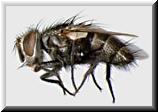Reared specimens examined. Exorista mella (Walker): A series of 28 adults reared from bertha armyworm collected from Asquith, Saskatchewan during 20-22 August 1979 (SRCS). Ten of the 28 parasitoids emerged from host pupae, whereas the host stage at emergence of the other 18 specimens was not indicated.
Exorista mella (Walker) is a common tachinid that has been reared from bertha armyworm in Alberta and Saskatchewan, albeit rarely (Wylie and Bucher 1977, Turnock 1984). This species is very similar to E. larvarum (L.) which parasitizes Mamestra brassicae in the Palearctic region (Turnock 1984); it was introduced into New England several times this century for control of the gypsy moth, Lymantria dispar (L.), and is presumably established though its current distribution in the New World has not been determined. Exorista has four Nearctic species in addition to mella and larvarum: E. rufostomata (Bigot), an unrecognized species; E. mimula (Meigen), restricted to the far northwest; E. dydas (Walker), widespread; and E. trudis Reinhard, widespread. No key to the Nearctic species is available.
Recognition. Exorista belongs to the Exoristinin and as such shares the characteristics of the tribe given above under Chetogena. Exorista can be distinguished from other exoristines by eye bare, facial ridge with weak decumbent setae (not stout erect setae), frontal setae descending to level of middle of facial ridge, and wing appearing creased beyond bend of vein M. See Sabrosky and Reardon (1976) for a complete description of the genus.
Exorista mella and E. larvarum are known to hybridize in the laboratory and may do so in nature as well. These species are so similar that the spread of E. larvarum from its introduction points in New England has not been well documented, though in Canada the species seems to have spread into Quebec and Ontario (CNC). Sabrosky and Reardon (1976) studied specimens of E. mella and E. larvarum of known identity and developed the following set of characters by which to separate them, noting that these characters "may not prove to be consistently useful": "Mesonotum and dorsum of abdomen, and intermediate abdominal segments on anterior 1/2 to 2/3 of each segment, heavily yellowish gray tomentose; parafrontals usually yellow to golden yellow, especially in males - Exorista larvarum (L.); Mesonotum and abdomen darker, especially in males, bluish-gray tomentose, the shining bands on intermediate abdominal segments often broader than in larvarum; parafrontals often gray to yellowish, occasionally golden - Exorista mella (Walker)" (Sabrosky and Reardon 1976: 15-16). Typical length is 8-13 mm.
In addition to E. mella and E. larvarum, there are three other Exorista species in the Nearctic region (excuding E. rufostomata (Bigot), an unrecognized species): E. dydas (Walker), E. mimula (Meigen) and E. trudis (Reinhard). Exorista mimula is known only from the Yukon in the Nearctic region. The other two species are usually smaller than E. mella and E. larvarum, each typically 7-10 mm long. Both occur in southern Canada and can be distinguished from E. mella and E. larvarum by the presence of 3 postsutural dorsocentral setae (4 in mella and larvarum). In addition, E. dydas has 1 pair of weak to strong median discal setae on abdominal terga 3 and 4 (these discals absent in mella and larvarum), and the male of E. trudis has the lateral lobe of abdominal sternite 5 deeply bifid (not bifid in mella and larvarum).
The puparium of E. mella was described and illustrated by Greene (1922, as Tachina mella) and illustrated by Ross (1953) and Sabrosky and Reardon (1976).
Biology. Eggs of exoristines, as mentioned above under Chetogena, are deposited directly on the body of a host larva and are not ready to hatch for several days. Schaffner and Griswold (1934) note the following about the life history of E. mella in the northeastern United States: usually 1 or 2 larvae per host (up to 11 recorded), 2-3 generations per year, larval stage overwinters in host larva or pupa, and adults active from May to October.
Sabrosky and Reardon (1976: 51) cite an "often-mentioned" biological difference between E. larvarum and E. mella: "larvarum maggots always leave the host before pupating, whereas maggots of mella pupate within the remains of the host." The single specimen of E. mella reared by Wylie and Bucher (1977) emerged as a larva from a larval bertha armyworm, whereas most (if not all) 14 reared specimens of E. mella examined by the author issued from host pupae (see above). The biological difference noted by Sabrosky and Reardon (1976) may not be reliable and warrants further investigation.
The known hosts of E. mella include a tenthredinid sawfly and many species of Lepidoptera belonging to the families Arctiidae, Bombycidae, Danaidae, Lasiocampidae, Lymantriidae, Noctuidae, Notodontidae, Nymphalidae, and Saturniidae (Arnaud 1978).
Distribution. Exorista mella ranges throughout southern Canada and the United States (Sabrosky and Reardon 1976).


